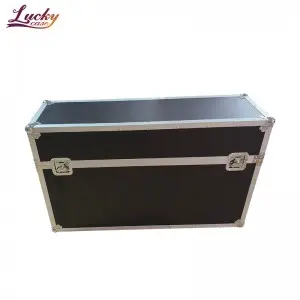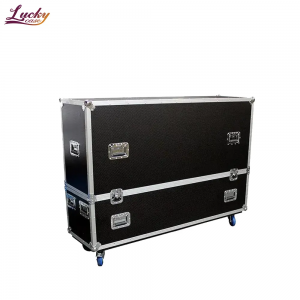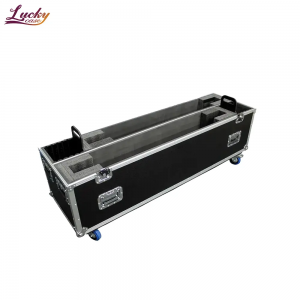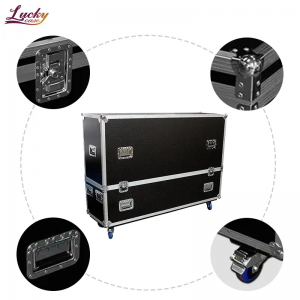In the air cargo industry, ensuring that fragile, high-value electronics arrive intact is a non-negotiable part of your reputation and your bottom line. Televisions—especially large-format or commercial-grade models—are among the most delicate and damage-prone items to ship. Unlike typical retail deliveries, air freight subjects shipments to repeated loading, handling, pressure changes, and vibration. So what’s the best way to protect a TV during air transport? The answer is the flight case—a reusable, shock-resistant container designed specifically for moving sensitive equipment across long distances. For air cargo distributors who routinely handle high-value shipments, integrating flight cases for electronics into your service offerings can increase client satisfaction, reduce damage claims, and improve operational efficiency.



Why Original TV Boxes Don’t Work for Air Freight
Manufacturers ship TVs in cardboard boxes because it’s cost-effective for one-time transit, not for repeat handling or air transport environments. These boxes offer minimal structural support, no weatherproofing, and very little shock absorption beyond the basic foam inside.
When cargo is loaded and unloaded multiple times—often by different handlers—cardboard simply doesn’t cut it. TVs in factory packaging are vulnerable to:
- Compression from heavy stacking
- Punctures or tears from shifting loads
- Internal component damage due to vibrations
- Moisture or condensation during air pressure changes
That’s why many logistics pros now recommend replacing or supplementing these boxes with a heavy-duty flight case for any high-value screen or monitor.
What Makes a Flight Case Ideal for TV Transport?
A flight case (sometimes called a road case) is a protective transport container made of industrial-grade materials like aluminum, ABS plastic, or laminated plywood, reinforced with metal edges and high-impact foam interiors.
Here’s why a custom flight case is an essential tool for air cargo distributors:
- Impact Protection: The combination of a rigid shell and foam padded flight case interior absorbs impact during loading and handling—protecting fragile screens from drops, tipping, or vibrations.
- Moisture and Dust Resistance: Many aluminum flight case designs include weatherproof seals to prevent moisture ingress during cabin pressure fluctuations or exposure on airport tarmacs.
- Stackability: Unlike soft or irregular boxes, flight cases are designed with reinforced corners and flat tops for secure stacking, optimizing space inside aircraft cargo holds.
- Mobility: Many flight cases come equipped with handles or wheels, making them easier for your staff or your clients to maneuver on-site or at the destination.
Why Air Cargo Distributors Should Recommend Flight Cases
For B2B clients such as TV retailers, AV rental services, or production companies, damage during transport results in delays, disputes, and loss of business. When you offer or require use of protective flight cases, you’re not just reducing breakage—you’re improving your customer’s experience.
Flight cases:
- Lower insurance risk by reducing the chance of damaged goods
- Streamline packaging and loading, since their uniform shapes are easier to handle
- Enhance your brand as a high-value logistics provider who thinks proactively
If you partner with a flight case manufacturer, you may even offer custom branding or tailored interior foam cutouts for frequent clients who regularly ship TVs or monitors.


Tips for Using Flight Cases in TV Air Cargo Logistics
- Verify Internal Fit: Choose a flight case that fits your specific TV model, or work with a custom flight case provider to match your client’s equipment.
- Inspect Foam Interiors Regularly: Foam lining wears over time. As a cargo handler or packaging partner, inspect interiors for tears or compression after each use to ensure full protection.
- Use Lockable Closures: For added security, choose flight cases with butterfly latches that can be padlocked. This deters tampering and keeps contents intact during turbulence.
- Label Clearly and Consistently: Use durable, printed labels such as “FRAGILE,” “SCREEN,” or directional arrows to guide ground handlers.
- Offer Rental or Reuse Options: Flight cases are reusable. Consider offering case rental for clients who only need them occasionally, adding a value-added service to your logistics operation.
Sourcing the Right Flight Case for TV Shipping
Choosing the right flight case manufacturer can make all the difference. Look for suppliers that offer:
- Custom foam interiors
- Stackable designs with reinforced corners
- Flight case with wheels for easier mobility
- Durable hardware and optional waterproof seals
- OEM branding options for your high-volume clients
A quality flight case is not a cost—it’s an investment in reduced liability, improved service delivery, and long-term client retention.
Conclusion
For air cargo distributors, transporting TVs doesn’t have to mean risking cracked screens, broken mounts, or unhappy clients. A flight case is a robust, professional solution that enhances your efficiency while safeguarding the value of every shipment. By integrating custom flight cases into your packaging standards or service options, you’re not just protecting freight—you’re elevating your entire business model. Don’t leave TV transport to chance. Use a flight case—and deliver confidence, every time.
Post time: Jun-24-2025






